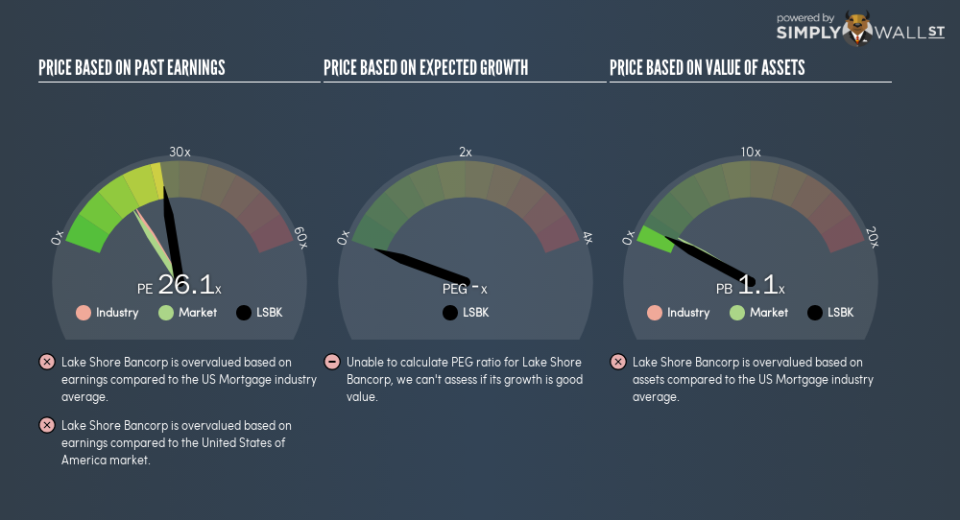What Does Lake Shore Bancorp, Inc.’s (NASDAQ:LSBK) P/E Ratio Tell You?

This article is written for those who want to get better at using price to earnings ratios (P/E ratios). To keep it practical, we’ll show how Lake Shore Bancorp, Inc.’s (NASDAQ:LSBK) P/E ratio could help you assess the value on offer. Lake Shore Bancorp has a price to earnings ratio of 26.06, based on the last twelve months. In other words, at today’s prices, investors are paying $26.06 for every $1 in prior year profit.
See our latest analysis for Lake Shore Bancorp
How Do You Calculate A P/E Ratio?
The formula for P/E is:
Price to Earnings Ratio = Share Price ÷ Earnings per Share (EPS)
Or for Lake Shore Bancorp:
P/E of 26.06 = $15.31 ÷ $0.59 (Based on the year to September 2018.)
Is A High Price-to-Earnings Ratio Good?
A higher P/E ratio means that buyers have to pay a higher price for each $1 the company has earned over the last year. That isn’t necessarily good or bad, but a high P/E implies relatively high expectations of what a company can achieve in the future.
How Growth Rates Impact P/E Ratios
If earnings fall then in the future the ‘E’ will be lower. Therefore, even if you pay a low multiple of earnings now, that multiple will become higher in the future. Then, a higher P/E might scare off shareholders, pushing the share price down.
It’s great to see that Lake Shore Bancorp grew EPS by 22% in the last year. Unfortunately, earnings per share are down 2.7% a year, over 5 years.
How Does Lake Shore Bancorp’s P/E Ratio Compare To Its Peers?
The P/E ratio indicates whether the market has higher or lower expectations of a company. As you can see below, Lake Shore Bancorp has a higher P/E than the average company (16.6) in the mortgage industry.
Its relatively high P/E ratio indicates that Lake Shore Bancorp shareholders think it will perform better than other companies in its industry classification. The market is optimistic about the future, but that doesn’t guarantee future growth. So further research is always essential. I often monitor director buying and selling.
A Limitation: P/E Ratios Ignore Debt and Cash In The Bank
The ‘Price’ in P/E reflects the market capitalization of the company. In other words, it does not consider any debt or cash that the company may have on the balance sheet. Hypothetically, a company could reduce its future P/E ratio by spending its cash (or taking on debt) to achieve higher earnings.
Such expenditure might be good or bad, in the long term, but the point here is that the balance sheet is not reflected by this ratio.
Lake Shore Bancorp’s Balance Sheet
The extra options and safety that comes with Lake Shore Bancorp’s US$13m net cash position means that it deserves a higher P/E than it would if it had a lot of net debt.
The Bottom Line On Lake Shore Bancorp’s P/E Ratio
Lake Shore Bancorp trades on a P/E ratio of 26.1, which is above the US market average of 16.1. With cash in the bank the company has plenty of growth options — and it is already on the right track. So it is not surprising the market is probably extrapolating recent growth well into the future, reflected in the relatively high P/E ratio.
Investors should be looking to buy stocks that the market is wrong about. People often underestimate remarkable growth — so investors can make money when fast growth is not fully appreciated. We don’t have analyst forecasts, but shareholders might want to examine this detailed historical graph of earnings, revenue and cash flow.
But note: Lake Shore Bancorp may not be the best stock to buy. So take a peek at this free list of interesting companies with strong recent earnings growth (and a P/E ratio below 20).
To help readers see past the short term volatility of the financial market, we aim to bring you a long-term focused research analysis purely driven by fundamental data. Note that our analysis does not factor in the latest price-sensitive company announcements.
The author is an independent contributor and at the time of publication had no position in the stocks mentioned. For errors that warrant correction please contact the editor at editorial-team@simplywallst.com.

